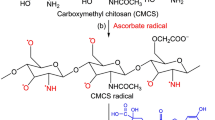Abstract
Chitosan oligomers with different molecular weights were prepared by oxidative degradation method involving hydrogen peroxide (H2O2) and the combined degradation method using hydrogen peroxide and microwave radiation. Viscosity determination and end group analysis were applied to measure molecular weights of chitosan oligomers. Effects of concentration of H2O2 and degradation time on molecular weights of chitosan oligomers were studied. Both methods were effective to prepare chitosan oligomers from the initial chitosan (8.5×105 Da). The degradation process of chitosan will be accelerated with the aid of microwave and degradation time may be reduced. The antioxidant activity of chitosan oligomers was evaluated as radical scavengers against superoxide anion and hydroxyl radical by application of flow injection chemiluminescence technology. Chitosan oligomers A, B, C and D (2300, 3270, 6120, and 15,250 Da) had different antioxidant activity. Among the four chitosan oligomers, oligomer D (15,250 Da) had the lowest scavenging ability against superoxide anion and hydroxyl radicals. For superoxide anion scavenging, the 50% inhibition concentrations (IC50s) of other three oligomers A, B, and C were 5.54, 8.11, and 12.15 mg/mL, respectively. And for hydroxyl radical scavenging the values were 0.4, 0.76, and 1.54 mg/mL, respectively. At the concentration range examined, the maximal inhibiting efficacy of A, B, C, and D were 89, 75, 74, and 41% for superoxide anion, and 71, 65, 51, and 7% for hydroxyl radical. These results indicated that chitosan oligomers with lower molecular weight had better antioxidant activity.







Similar content being viewed by others
References
Kofuji K, Qian CJ, Nishimura M, Sugiyama I, Murata Y, Kawashima S (2005) Eur Polym J 41:2784–2791
Qi LF, Xu ZR, Jiang X, Hu CH, Zou XF (2004) Carbohydr Res 339:2693–2700
Li WJ, Jiang X, Xue PH, Chen SM (2002) Chin Sci Bull 11:887–889
Zhao HR, Wang K, Zhao Y, Pan LQ (2002) Biomaterials 23:4459–4462
Hong KN, Na YP, Shin HL, Samuel PM (2002) Int J Food Microbiol 74:65–72
Chien PJ, Sheu F, Lin HR (2006) Food Chem, doi: 10.1016/j.foodchem.2005.10.068
Jung WK, Moon SH, Kim SK (2006) Life Sci 78:970–976
Liu N, Chen XG, Park HJ, Liu CG, Liu CS, Meng XH, Yu LJ (2006) Carbohydr Polym 64(1):60–65
Kim SK, Rajapakse N (2005) Carbohydr Polym 62:357–368
Yang YM, Shu RG, Shao J, Xu GF, Gu XX (2005) Eur Food Res Technol 222(1/2):36–40
Kim KW, Thomas RL (2006) Food Chem doi: 10.1016/j.foodchem.2006.01.038
Je JY, Park PJ, Kim SK (2004) Eur Food Res Technol 219(1):60–65
Guo ZY, Xing RE, Liu S, Yu HH, Wang PB, Li CP, Li PC (2005) Bioorg Med Chem Lett 15:4600–4603
Kogan G, Skorik YA, Zintnanova I, Krizkova L, Durackova Z, Gomes CAR, Yatluk YG, Krajcovic J (2004) Toxicol Appl Pharm 201:303–310
Sun T, Xie WM, Xu PX (2004) Carbohydr Polym 57:379–382
Huang RH, Mendis E, Kim SK (2005) Int J Biol Macromol 36(1/2):120–127
Xie WM, Xu PX, Liu Q (2001) Bioorg Med Chem Lett 11:1699–1701
Lin HY, Chou CC (2004) Food Res Int 37:883–889
Huang RH, Rajapakse N, Kim SK (2006) Carbohydr Polym 63:122–129
Je JY, Kim SK (2006) Bioorg Med Chem doi: 10.1016/j.bmc.2006.05.016
Wasikiewicz JM, Yoshii F, Nagasawa N, Wach RA, Mitomo H (2005) Rad Phys Chem 73(5):287–295
Wang SM, Huang QZ, Wang QS (2005) Carbohydr Res 340(6):1143–1147
Xing RE, Liu S, Yu HH, Guo ZY, Wang PB, Li CP, Li ZE, Li PC (2005) Carbohydr Res 340(13):2150–2153
Shao J, Yang YM, Zhong QQ (2003) Polym Degrad Stabil 82(3):395–398
Imoto T, Yagishita K (1971) Agric Biol Chem 35:1154–1156
Maghami GG, Roberts GAF (1998) Makromol Chem 189:195–200
Acknowledgments
This project was supported by the President's Special Foundation of Shanghai Fisheries University (SFU200305) and Shanghai Leading Academic Discipline (Project No. T1102).
Author information
Authors and Affiliations
Corresponding author
Rights and permissions
About this article
Cite this article
Sun, T., Zhou, D., Xie, J. et al. Preparation of chitosan oligomers and their antioxidant activity. Eur Food Res Technol 225, 451–456 (2007). https://doi.org/10.1007/s00217-006-0439-1
Received:
Revised:
Accepted:
Published:
Issue Date:
DOI: https://doi.org/10.1007/s00217-006-0439-1




